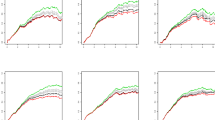Abstract
Introduction
In this article, we introduce Marginal Structural Models, which yield unbiased estimates of causal effects of exposures in the presence of time-varying confounding variables that also act as mediators.
Objectives
We describe estimation via inverse probability weighting; estimation may also be accomplished by g-computation (Robins in Latent Variable Modeling and Applications to Causality, Springer, New York, pp 69–117, 1997; van der Wal et al. in Stat Med 28:2325–2337, 2009) or targeted maximum likelihood (Rosenblum and van der Laan in Int J Biostat 6, 2010).
Conclusions
When both time-varying confounding and mediation are present in a longitudinal setting data, Marginal Structural Models are a useful tool that provides unbiased estimates.
Similar content being viewed by others
References
Austin PC, Grootendorst P, Anderson GM (2006) A comparison of the ability of different propensity score models to balance measured variables between treated and untreated subjects: a Monte Carlo study. Stat Med 26:734–753
Bodnar LM, Davidian M, Siega-Riz AM, Tsiatis A (2004) Marginal structural models for analyzing causal effects of time-dependent treatments: an application in perinatal epidemiology. Am J Epidemiol 159:926–934
Bryan J, Yu Z, van der Laan MJ (2004) Analysis of longitudinal marginal structural models. Biostatistics 5:361–380
Cole SR, Hernan MA (2008) Constructing inverse probability weights for marginal structural models. Am J Epidemiol 168:656–664
Fewell Z, Hernan MA, Wolfe F, Tilling K, Choi H, Sterne JAC (2004) Controlling for time-dependent confounding using marginal structural models. Stat J 4:402–420
Hernan MA, Brumback B, Robins JM (2000) Marginal structural models to estimate the causal effect of zidovudine on the survival of HIV-positive men. Epidemiology 11:561–570
Lefebvre G, Delaney JAC, Platt RW (2008) Impact of mis-specification of the treatment model on estimates from a marginal structural model. Stat Med 27:3629–3642
Moodie EEM, Stephens DA (2010) Using directed acyclic graphs to detect limitations of traditional regression in longitudinal studies. Int J Public Health (in press)
Moodie EEM, Delaney JAC, LeFebvre G, Platt RW (2008) Missing confounding data in marginal structural models: a comparison of inverse probability weighting and multiple imputation. Int J Biostat 4:13
Robins JM (1997) Causal inference from complex longitudinal data. In: Berkane M (ed) Latent variable modeling and applications to causality. Springer, New York, pp 69–117
Robins JM, Hernan MA, Brumback B (2000) Marginal structural models and causal inference in epidemiology. Epidemiology 11:550–560
Rosenblum M, van der Laan MJ (2010) Targeted maximum likelihood estimation of the parameter of a marginal structural model. Int J Biostat 6
van der Wal WM, Prins M, Lumbreras B, Geskus RB (2009) A simple g-computation algorithm to quantify the causal effect of a secondary illness on the progression of a chronic disease. Stat Med 28:2325–2337
Westreich D, MacPhail P, Van Rie A, Malope-Kgokong B, Ive P, Rubel D, Boulme R, Eron J, Sanne I (2009) Effect of pulmonary tuberculosis on mortality in patients receiving HAART. AIDS 23:707–715
Xiao Y, Abrahamowicz M, Moodie EEM (2010) Accuracy of conventional and marginal structural Cox model estimators: a simulation study. Int J Biostat 6
Acknowledgments
Both authors acknowledge funding from the Natural Sciences and Research Council of Canada. Moodie also acknowledges funding from the Canadian Institutes of Health Research.
Author information
Authors and Affiliations
Corresponding author
Rights and permissions
About this article
Cite this article
Moodie, E.E.M., Stephens, D.A. Marginal Structural Models: unbiased estimation for longitudinal studies. Int J Public Health 56, 117–119 (2011). https://doi.org/10.1007/s00038-010-0198-4
Received:
Revised:
Accepted:
Published:
Issue Date:
DOI: https://doi.org/10.1007/s00038-010-0198-4




